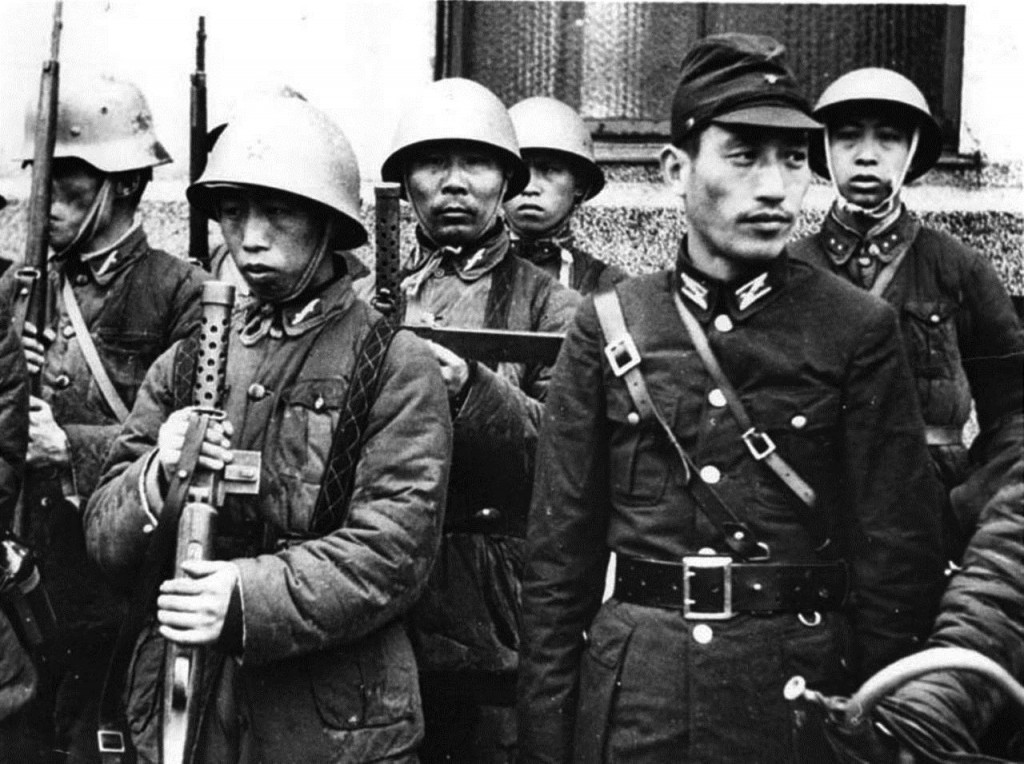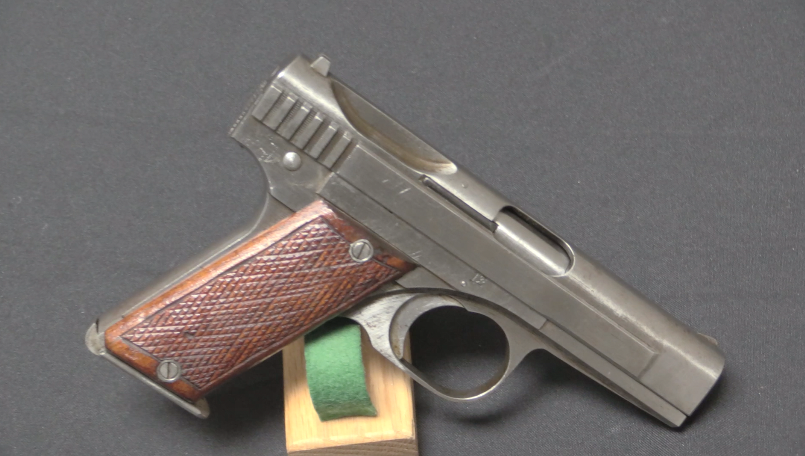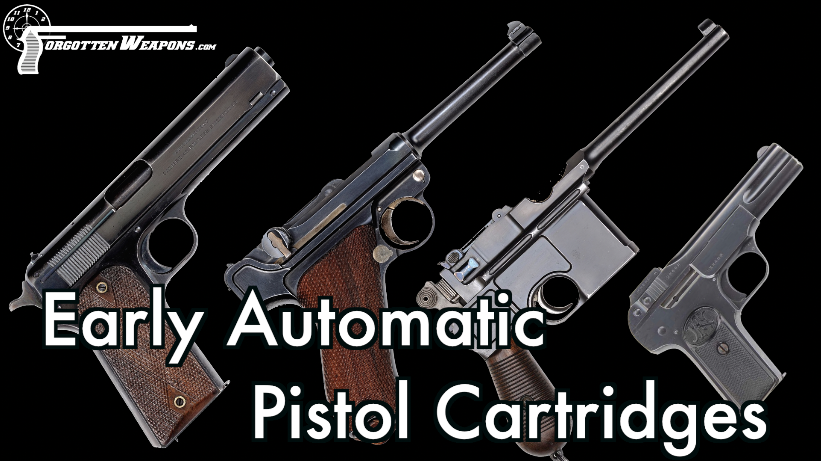
Japanese SNLF marines Chinese troops with SIG M1920 submachine guns. The SIG M1920 was a licensed copy of the German MP18/I, and SIG sold them to Japan in 7.63mm Mauser caliber. They were used by the Special Naval Landing Forces, as well as Chinese troops like those pictured here. Thanks to Leszek for the photo!
Edited: Based on the comments folks more knowledgeable than I, it appears that these are Chinese puppet troops, and not Japanese forces.




Oh man, those facial expression…. :-)))
Besides, one of the helmets looks different, kind like Chinese which in turn was like German.
At the time, the Japanese were experimenting with different helmet designs, including a modified kabuto style, before they finally settled on the definitive pattern seen in WWII.
Chinese used German style helmets in the 30’s. German forces under General von Falkenhausen fought the Japanese in Shanghai in the late 30’s. This was in support of the Guomindang. A lot of gear was later reused, naturally
Had occasion many years past to view a barrel receiver & clip from what I thought was a Japanese Bullpup SMG. I was shown to me by the person that took it out of a beached Zero fighter right at the end of the war, he was a hard hat diver for the navy. It was clamped inside the cockpit as a last ditch weapon , clip was full of shells 8mm Nambu. to have used it the bolt would have to be drawn back and let go and it would run till out of shells. Always thought that was interesting. Bob
I can find absolutely no evidence of any gun that works in this manner. In fact, I doubt that literally anything in Bob’s post is factual. If anyone can find evidence to the contrary, please send it to me.
Only plausible explanation I can think of is some fighter pilot wasn’t satisfied with their Type 94 pistol, so they “acquired” a Type 100 smg and took it out of its stock (which also houses the trigger and sear) with the idea that if they needed to use it they’d just yank the bolt back and dump the whole mag. It’s a dumb idea, but I’ve heard dumber. Either that or the stock was stashed separately to save space, and wasn’t recovered. Not much help if you’re ditching, but again people don’t just have good ideas.
“SIG sold them to Japan in 7.63mm Mauser caliber”
Why Japanese forces switch to 8×22 Nambu for use in SMG? They were disappointed with 7.63mm Mauser or they want only simplify ammunition production?
Japanese logistics were a nightmare as it was, what with multiple 7.9mm, 7.7mm and 6.5mm long gun cartridges, plus 8mm Nambu, plus 7mm Nambu, plus 9mm Revolver, plus whatever captured stuff they issued to second line troops.
SNLF were Navy and the Navy and Army always went their own ways… when they weren’t outright trying to kill each other. My college adviser was a Korean who said the Army and Navy were running competing intel… and narcotics operations in China, and that it wasn’t unusual for them to come to blows.
The 8 x 21mm Nambu round was ballistically equivalent to the 7.65 x 20mm French or 7.65 x 17mm Browning (.32 ACP) rounds, with an 85-grain bullet at 1065 F/S, or a 100-grain bullet at 1000 F/S. As such, it’s doubtful that it developed enough recoil force to operate the bolt of the MP.18-type weapon.
The Japanese Army’s own indigenous SMG design, the Type 100, was designed around the 8 x 21mm, and tried to cope with the relatively weak recoil impulse by using a lighter bolt and spring combination. It also had a Suomi-style “airlock” buffer to control the cyclic rate of fire, which could be adjusted from a a “high” of 800 R/M to a “low” of 450 R/M. (A roughly analogous system, in results if not mechanism, was used on the U.S. M1918A2 BAR in .30-06.) Exactly why they went to the trouble, no one seems to be able to adequately explain, even today.
While the Type 100 was lighter than the MP.18 “clone”, it was also more complicated to manufacture, and by the time it entered limited production (mid-1944), the Japanese arms industry was having a hard enough time delivering the standard rifles, pistols and MGs in worthwhile quantities.
Also, the SMG was seen primarily as a “special forces” weapon, for the naval landing forces and paratroops, so there wasn’t much interest in devoting factory space and materiel’ to a special weapon for them, when the rank-and-file needed Type 99 bolt-action rifles and any MG they could get as badly as they did.
A more single-minded development program could have given the Japanese forces a standard and probably easily mass-produced SMG before the war in the Pacific started. (A copy of the Erma MP-38 in 7.63 x 25mm, like the much later Yugoslav Model 56, would have been highly interesting.)
But there was no particular interest at the command level early on, and by the time they realized the usefulness, if not necessity, of SMGs for the sort of war they were fighting, it was entirely too late to do much, if anything, about it.
cheers
eon
7.65mm Browning is significantly weaker that either the 8mm Nambu or 7.65×20 “Longue”. The latter was the most powerful of the three; the standard French military load was 85 grains bullet at about 1120 ft/s (100mm barrel). 90 grain bullet was used as well with muzzle velocity of 1050 ft/s. The CIP max. piezo pressure is 23,931 psi and modern re-loads with a 93 grain bullet at 1,198 ft/s are within that limit, which puts it almost into the 7.65×21mm Parabellum territory. Some French sources also mention up to 360 m/s (1,180 ft/s) muzzle velocity with the original 85 grain bullet.
i always found the lack of smg usage in the Japanese forces a bit odd
I do as well. They were almost always engaged in battle areas that didn’t require long range rifles.
Not so in China and especially in Manchukuo/Inner Mongolia. That’s wide open country so flat and featureless, paper maps are often useless. During the Battle of Nomonhan, one Japanese infantry unit thought they’d captured their objective, a “hill” not much higher than a living room ottoman, only to discover that they were hundreds of meters short of the actual objective.
It was one reason for the switch from 6.5x50mm to 7.7x58mm.
“7.7x58mm”
To make this even more complicated existed different 7.7 for rifles and different 7.7 for machine gun. On the other hand the Type 11 machine gun was designed to not only use the 6.5 rifle ammo but also rifle’s clip.
Forces which use 6.5 rifle ammo often developed special machine gun round like Italian 8×59 Breda or Swedish 8×63 patron m/32, but making new bigger cartridge for rifle and another one for machine gun is odd.
When guns are captured ammo is usually captured also so it don’t make bigger problems unless the guns are planned for longtime usage, see German Fremdengerät list to see how many different guns were captured by Wehrmacht
For that matter the hills of Hebei, the province surrounding Beijing, resemble the largely treeless mountains of parts of eastern Montana. The rest of the province is flat farmland. This was the scene of a lot of fighting in WW2. Think mule deer country. A full sized rifle was the weapon of choice.
They had them, in various flavors. They just didn’t have the resources to produce enough rifles and machine guns, nevermind what was considered “specialist” equipment.
WWII was a war of logistics, one which the Japanese lost virtually before it began.
We must not forget that before WW2 started almost no country issued SMGs as standard infantry weapons. The Germans considered them useful for military police, sentries and officers’ self-defense weapons, but not for general issue. The Soviets did not know what to do with them before the Winter War. The Italians did not issue large numbers of SMGs to infantry until December 1941 (small numbers of Beretta M1918 and OVP were available), even though they had an excellent (albeit expensive) design in the Beretta M1938. In UK the story was much the same. The French actually had plans for fairly wide issue of the MAS-38 in 1940 (possibly inspired by the success of the Suomi SMG in the Winter War), but production was just starting to take off in May 1940.
The officer’s(?) collar tabs seem a bit odd to me, with the diagonal insignia running through them. If I can figure out where it is, I’ll take a look at my Osprey book on the SNLF.
They were experimenting with uniforms and insignia at the time too. Eventually SNLF field uniforms were basically an OD green equivalent of the tan/khaki Army uniforms with some detail differences.
According to the internet here in China, the troops are those of Yang Jing Yu 杨靖宇,a war Lord of sorts who threw in with the Chinese Communist Party AGAINST the Japanese. The weapons most likely are captured.
This photo is not Japanese soldiers, officer is wear uniforms ROC army.
May be puppet troops,
My thoughts exactly. I kept looking at them, and neither the “officer” nor the EMs looked that “Japanese” to me.
The EM’s uniforms look a little off to me as well.
My guess would be that they’re troops from Wang Ching Wei’s puppet army, or one of the similar collaborationist regimes which the Japanese used as proxies. The National People’s Army (and warlord forces) had a variety of submachine guns before the start of the Second Sino-Japanese War.
For Cris,
You are so correct that the bulk of the Japanese army was fighting in the plains of China and the north where long range weapons were winners.
But when resources are short, it is surely cheaper to stamp an smg than machine a rifle.
It is said that generals plan on their last successful war. True enough, but at least the nasty shocks of 1939 and 1940 convinced the Allied generals that ‘gangster weapons’ like the Sten, Thompson, Owen or MK3 might be useful against gangsters.
The Japanese did not learn this after their defeats at Guadalcanal and Kokoda in 1942. Thank heavens, in 1943 they could have easily cranked out 100,000 of these cheap smg which would have been useful for them in the jungles of Burma, Philippines, New Guinea and close fighting of Okinawa and intense urban fighting of…Japan
It was seriously stupid for the IJA to ignore the smg.
More Japanese SMGs might have raised the overall cost in casualties to the Allies, but wouldn’t have changed the ultimate outcome.
The Japanese war effort was fatally hampered by the fundamental nature of the Japanese social structure, government and military.
A million Stens or PPShes couldn’t overcome the mindset that doomed the Japanese at Nomonhan, the Bismarck Sea, and Guadalcanal. The Japanese could only have won if we’d been as weak and feckless as they imagined us to be, and that was never anything but a racist delusion.
Their own psychopathologies defeated the Japanese and Germans as surely as Allied force of arms.
If having a smg would have won the war in China for the Japanese, it might have won them the war. The war in the Pacific was mainly a war of ships and airplanes and a smg wouldn’t have made a huge difference.
When the Japanese military seen that the war in China was far from over and the war in the Pacific was lost, the developed a plan to be able to fight thru 1946. After that they know they’d be totally out of the resources needed to continue.
There is the US Naval reports over on the F-T archive site about what the plan was for food and fuel thru 1946. By 1945 they weren’t able to have enough fuel for their inter-coastal commercial boats nor their fishing fleet. They had even tested how to run the boats that had hot-bulb engines on creosote.
Fuel ethanol and food production was sweet potato based. Fuel for fighter planes was based on making gasoline from pine tree roots as the fighter planes of the day wouldn’t run on ethanol due to the length of the intake manifolds.
Maybe most wars are have always been more about logistics than the weapons used. It’s just the weapons are more interesting and easier do correctly.
“If having a smg would have won the war in China for the Japanese, it might have won them the war.”
Given that while the Japanese never could actually subdue China, they were never in danger of losing it until the day they surrendered, SMGs would have made no difference to that. They were ADVANCING in China in the last twelve months of the war. They were doing just fine in China with bolt action rifles and machine guns.
Ironically, the greatest strengths of the Japanese in China were almost exactly the same that were their major weaknesses against Soviet and Western armies: they had much more artillery and tanks than the Chinese with reasonably well trained crews. Artillery was often used in direct fire mode, since the Chinese could not respond in kind. The ability to use direct fire also alleviated the fact that most of the Japanese artillery pieces were light 75mm guns. In China the Japanese often had air superiority and the Chinese were very short of AA weapons, which allowed the Japanese to use their otherwise obsolescent-at-birth light bombers (Ki-30, Ki-32 & Ki-51; similar to Fairey Battle) to a good effect.
The first Japanese attempt to use massed indirect fire artillery actually came in Okinawa and was initially a small shock to the US forces there, mostly because they did not think the Japanese army capable of such thing. Of course the US air and artillery superiority quickly forced the Japanese to pull their remaining artillery back to shelters, so it had no strategic effect, but it showed that the Japanese were finally learning. They also planned to use massed armor for the defense of the home islands and hoarded all the latest and many of the older model tanks for that purpose. However, needless to say, at that stage it would not have made any difference.
Hey, Kaigun Tokubetsu Rikusentai. My father’s old outfit. Yeah he carried a SMG (dunno what type, he never said) and kinda resembles that officer (It’s not him, my dad was not an officer).
got any picture of your dad in the service you are willing to share ?
what is with the soldier in the second row left wearing a national Chineese helmet?
sorry finally read the great comments after i posted, as always great and knoweldgeable inputs
Guys,I’m a Chinese,and here I must say It’s a puppet army called“华北绥靖军(if we can translate it as”Huabei Appeasement Army”)”,in Huabei Area(Include Hebei Province,Shandong Province,”rehe”Province,ect.),not Japanese,nor SNLF
If I recall correctly, there were at least two or three puppet regimes in addition to Wang Ching Wei’s I think they’re at least referred to in one or more of the Osprey “Men at Arms” series. While doing a bit of quick research I saw somebody on a WWII forum claim that the Wang Ching Wei forces numbered in the vicinity of 1,000,000 men, something I find VERY hard to believe. Of course I can claim that half of the population of Rocky River, Ohio owes its allegiance to me. That doesn’t make it so. I’d wager that the troops Wang did have were about as reliable as a Chauchat made in a back alley in Peshawar.
I agree with Mark Lee, KNO3 and Chris Morton — those are definitely not SNLF, and most likely Chinese puppet forces troops. Speaking of the actual SNLF or Japanese Marines, those guys were some of the toughest combat troops in the world, bar none. Their battlefield record in the Pacific War clearly bears this out, and they gave Allied forces no end of serious trouble wherever they were encountered, even when the odds were overwhelmingly stacked against them.
http://sakuramochi-jp.blogspot.com/2012/12/japanese-invasion-of-china-1931-45.html
look this
Does one of the Japanese soldiers have a german helmet on his head?
Hi, Jerry :
Please see the previous comments and contributions regarding the fact that these soldiers were probably not actually Japanese Marines ( SNLF ), but were instead Chinese partisan troops who were part of any one of the numerous factions that existed at the time in China, which would explain the disparity in personal equipment, including the German “coal-scuttle” helmet being used by the individual on the far left of the photograph.
I did not know that and will try to updated myself on the comments. Thank you so much, I love reading your site when I can.
You’re welcome! I love this web site too — I think Ian McCollum and his team have done an incredible job with FW, and we are really fortunate to have so many open, knowledgeable and interested contributors and readers with a wide diversity of viewpoints who are still respectful of one another.
Ian, I do apologize if it sounds as if I am speaking on your behalf or anyone else’s on FW for that matter. That is not my intention at all. I am merely being honest with how I see things.
Hey, Jan, don’t you say anything about that Jap with nazi helmet ?!
Fab
这是中国伪军,大汉奸梁鸿志伪维新政府的伪维新绥靖军
This is Japan’s Chinese puppet army,Liang Hongzhi’s reform and National Salvation Army